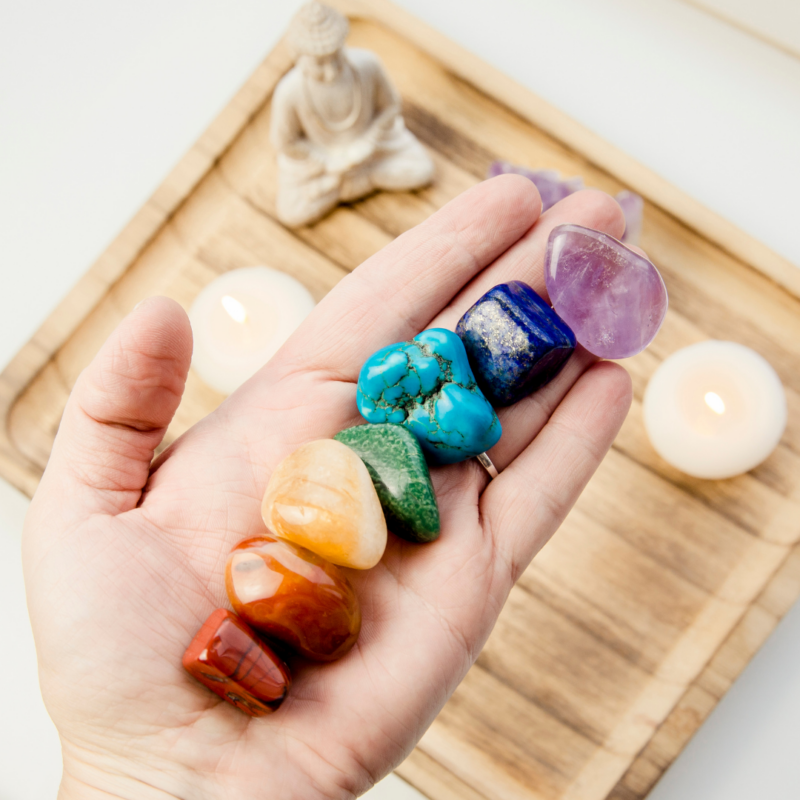You might have come across someone talking about “unblocking their chakras,” but have wondered what exactly that means and, well, what’s even a chakra, anyway? If you’re new to this quite fascinating spiritual concept, we’ve created an easy crash course to get you familiarized—read on below to learn more.
What is a chakra?
A chakra is essentially an energy center and is Sanskrit for “wheel.” There are seven chakras located throughout the body (you can think of them like invisible wheels of energy), and each is associated with various colors and symbols which represent different meanings. Chakras are thought to help you lead a normal and healthy life, but they’re also prone to blockages. In fact, in today’s hectic world, fully balanced chakras are quite rare to come by.
Tell me more…
Now, let’s take a closer look at each of the chakras and what they’re all about. For further learning, check out the book: Chakras for Beginners: The 7 Chakras Guide on How to Balance Your Energy Body Through Chakra Healing:
-
The Crown Chakra: Governed by the color purple, the crown chakra is located at the top of your head, and when it’s out of whack, you may experience problems with concentration or other issues with mental wellbeing. The best way to support this chakra is to engage in activities that open up your mindset and help stave off anxiety like yoga.
-
The Third Eye Chakra: Located between your eyebrows, the third eye chakra (linked to the color indigo) is responsible for all kinds of things when blocked from lack of intuitive thought to sinus problems—emotional issues are believed to be associated with a blockage of this chakra, too. Indulging in a basic form of meditation for a half hour each day can help activate and cleanse the third eye chakra, leading to improved self-awareness and intuition.
-
The Throat Chakra: The throat chakra—governed by the color blue—is located right at the middle of your throat and gives voice to your beliefs and values. When balanced, you’re able to openly speak the truth and the main way to help keep this chakra running smoothly is to take up activities that’ll help you voice your opinions freely—perhaps by joining a group where you can discuss your ideologies about a topic or showcase your expertise.
-
The Heart Chakra: This chakra can be found in your chest around the space of your heart and is associated with the color green. Fundamentally about love, when this chakra is balanced, you’re able to easily feel love and empathy for yourself and others. Alternatively, if you’re feeling emotional imbalances like jealousy or insecurity with relationships, it’s likely this chakra is out of alignment. One suggestion to free up this chakra is to talk your emotions out or perhaps write your feelings down and pass the note along to the person involved if you have trouble communicating freely.
-
The Solar Plexus Chakra: Located in your stomach—about 2-3 inches above your belly button—this chakra helps support boundary-setting and is associated with the color yellow. When balanced, a sense of high-self-worth and confidence can be felt, and when it’s out of whack, this chakra is associated with digestive issues and even chronic fatigue. One tip to help balance this chakra is to focus on your management skills by taking control of a situation that requires leadership. You’ll feel your self-confidence is high and that you’re able to handle various situations when the solar plexus chakra is functioning optimally.
-
The Sacral Chakra: The sacral chakra is associated with orange and located just below your belly button—it governs the organs around your stomach and represents creative and sexual energies. An imbalanced sacral chakra might present itself in ways like lack of creativity or emotional issues. Working on expressing your feelings instead of keeping them inside is one way to help keep this chakra balanced.
-
The Base/Root Chakra: Finally, the root chakra is governed by the colors red and black and can be found at the bottom of the tailbone. This chakra is the most important one and related to everything you need in life in order to survive like breathing, eating, sleeping, and feeling a general sense of security. When balanced, you’ll feel a deep sense of peace. The book points out that one natural way to cleanse this chakra is to regularly eat root veggies like potatoes, beetroots, carrots, onions, etc. Another easy technique to help improve the health of the root chakra is to perform mundane tasks to keep you grounded like sweeping the floor.
Additional tips for balancing chakras
As we mentioned above, each of the chakras is associated with a particular color, and one great way to cleanse any blocked chakras is through the use of colored stones or gemstones. For example, the third eye chakra is governed by indigo, so you’ll want to reach for amethyst or purple fluorite. The Chakras for Beginners book recommends placing the stone between your eyebrows for 15 minutes—once this chakra is cleansed, you might see a considerable improvement in your self-confidence. For a quick rundown on gemstones associated with the other chakras, reach for black tourmaline or red agate when it comes to the root chakra, carnelian or coral for the sacral chakra, citrine or topaz for the solar plexus one, tourmaline or jade for the heart chakra, aquamarine or lapis lazuli for the throat chakra, and selenite or quartz for the crown chakra.
Simple lifestyle changes can also help keep your chakras aligned, for example, incorporating mindfulness into your routine (which can help with all seven chakras.) Mindfulness meditation is incredibly useful and can be done by sitting in a space you find to be inspirational; the idea is to simply be in the present moment without getting distracted by other thoughts. Certain yoga poses can assist with clearing any blocked chakras, too, like the cat cow pose which can help with the heart chakra since it stretches the shoulder muscles and allows the heart area to open. Child’s pose is a great one for the solar plexus and sacral chakras since it focuses on the lower part of the body and can get energy flowing there. Lastly, the book recommends working on chakras from the bottom up, so if you think your root chakra is imbalanced, first spend some time focusing on getting that one strong before moving upwards to the others.









